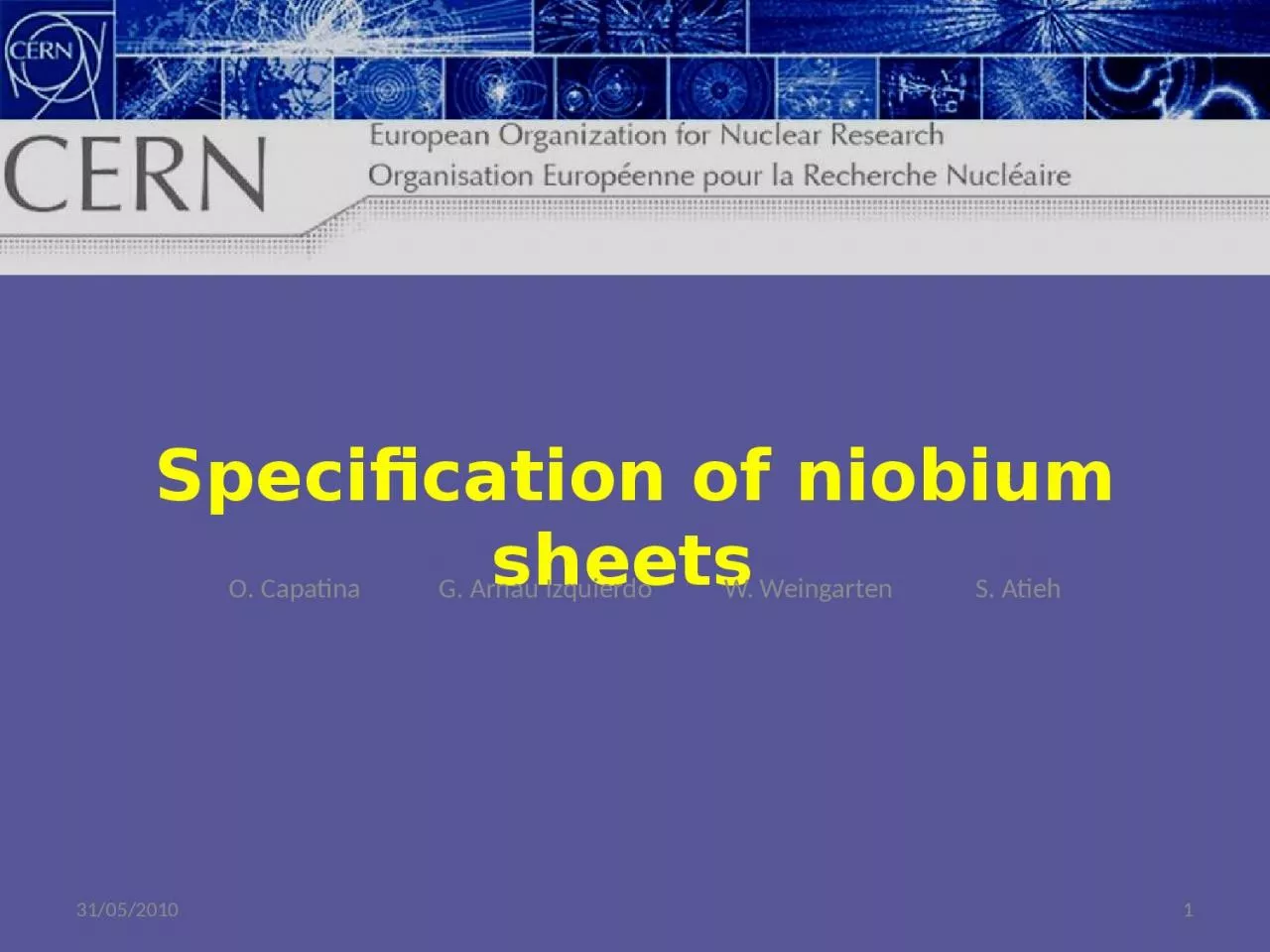

0 31052010 O Capatina G Arnau Izquierdo W Weingarten S Atieh 1 GENERAL CHARACTERISTICS Chemical composition PURE NIOBIUM based on ASTM B393 Type 5 UNS R04220 ID: 1002330
Download Presentation The PPT/PDF document "Specification of niobium sheets" is the property of its rightful owner. Permission is granted to download and print the materials on this web site for personal, non-commercial use only, and to display it on your personal computer provided you do not modify the materials and that you retain all copyright notices contained in the materials. By downloading content from our website, you accept the terms of this agreement.
1. Specification of niobium sheets 031/05/2010O. Capatina G. Arnau Izquierdo W. Weingarten S. Atieh
2. 1GENERAL CHARACTERISTICSChemical composition: PURE NIOBIUM “based on ASTM B393, Type 5, UNS R04220 with further requirements“ RRR 300 grade (Type 5, UNS R04220) Limits for the main impurities:ElementMax. Content wt%Ta0.050W0.007Ti0.005Mo0.005All other metallic impurities, each0.003H20.0002N20.0010O20.0010C0.001031/05/2010Technical Specification Sheets shall be made from ingots produced by electron beam vacuum melting. Forging and rolling shall be made in clean conditions to avoid any contamination with foreign particles. Final annealing shall be made in a proper vacuum of 2∙10-5 torr or better.ASTM B393 – 09e1 Standard specification for Niobium and Niobium Alloy Strip, Sheet, and Plate. EN 10204:2004 Metallic products: Types of inspection documentsASTM E112-96(2004)e1 Standard method for determining average grain sizeprEN 4050-4:1994 Aerospace series - Test method for metallic materials; ultrasonic inspection of bars, plates, forging stock and forgings - Part 4: Acceptance criteriaISO 4287:1997 Geometrical Product Specifications (GPS) -- Surface texture: Profile method -- Terms, definitions and surface texture parametersISO 4288:1996 Geometrical Product Specifications (GPS) -- Surface texture: Profile method -- Rules and procedures for the assessment of surface texture
3. 2GENERAL CHARACTERISTICS31/05/2010Homogeneity and surface quality:Parallel surfaces (RF side & back side) and bulk material have to be free of defects Surface defects:RF side, surface roughness Rt ≤ 15 µm.back side, surface roughness Rt ≤ 60 µm.visual inspection and optionally by Eddy current(according to a written procedure approved by CERN) Bulk defects:shall be ultrasonically inspected for the presence of continuity faults and for variations of attenuation which are indicative of microstructural heterogeneities. Structure:Grain size number 6 or finer According to ASTM E112-96(2004)e1 Mechanical:Tensile strength Rm min. 140 N/mm2Yield stress Rp 0.2% min. max.50 N/mm2100 N/mm2Elongation at break A5 min.30%Vickers hardness HV10 max.60
4. 3QUALITY CONTROL31/05/2010TestFrequencyChemical analysis other than H2, N2, O2 and CEvery melt H2, N2, O2 and CEvery batch on final productStructural analysisEvery batch on final productTensile mechanical propertiesEvery batch on final productHardnessEvery item (location to be agreed)RRREvery batch on final productVisual inspectionEvery item, 100 % on both sidesEddy current inspection (option)Every item, 100 % on both sidesUltrasonic for continuity faultsEvery item and/or intermediate product, 100 % Ultrasonic for variations of attenuationEvery item, 100 %RoughnessEvery batch on final productDimensionsEvery itemTests carried out by the manufacturer for each item delivered. Items are considered in the same batch if they have in common: melt, rolling and have been annealed in the same charge
5. 4Dimensions31/05/2010 Sheet dimension (half cell shape) are determined by the manufacturing process For small series spinning is more adapted than deep drawing or hydro forming Establish sheet main dimensions, spinning test has been carried out with following outcomes:Required sheet Ø ≈ 520 mm → dimension 520 mm x 520 mmThickness:optimised start thickness is 3.5 mmspinning t loss - 0.6 mmthickness tolerances - 0.1 mmchemical etching and EP - 0.2 mmStarting thickness 3 mm & 4 mmLoss in thickness ≈ 0.6 mmTacking into account
6. 5Dimensions31/05/2010t 3.5 mmØ 520 mmSampling, witness pieces, tests, etc.Final sheet dimension: 520 mm x520 mm x t 3.5 mm
7. 6Open points31/05/2010 Stiffening rings in Nb RRR40→ specification is done Interface Nb to NbTi and Ti tank to done Extremities to done in tubes or spinning? Quantities to checked